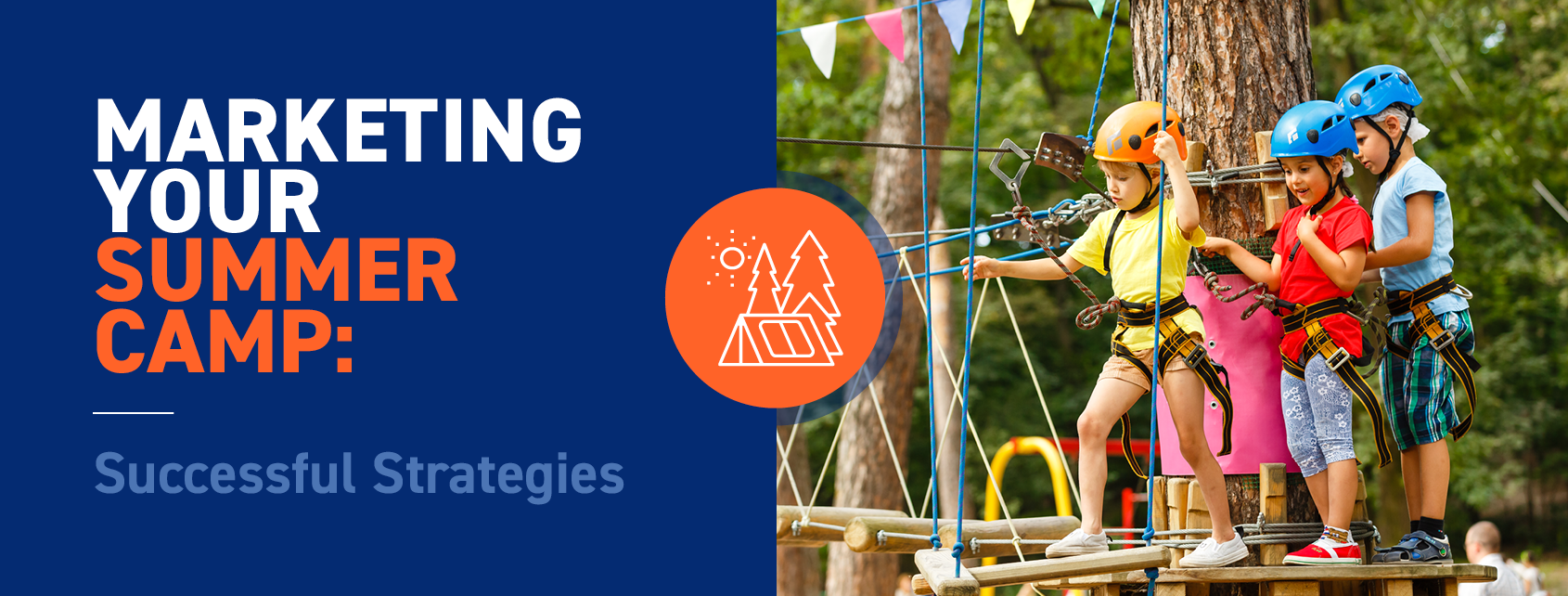Summer camps are vibrant, exceptional places where children and teenagers can spend their summer participating in enriching activities. Behind the scenes, a lot of work occurs to make this possible. Camp directors and staff members plan activities, manage camp finances, fundraise, maintain camp facilities and equipment, and more. However, to ensure that you have enough campers in attendance to run a thriving camp, you need a thorough marketing plan.
To help you round out your promotional efforts, we’ll cover five successful marketing strategies you can implement to secure the interest and enrollment of potential campers. By the end of this guide, you’ll know how to get the word out about your camp and obtain all the registrations you need.
1. Customize your camp’s branding.
Most summer camps are technology-free, providing a unique experience for children in today’s technologically-centered world. Despite the lack of technology at camp, however, you still need an online presence to broaden your outreach. And that’s where branding comes in—according to Fifty and Fifty, consistent branding helps increase credibility and attracts new campers to your organization.
For most parents and campers, the first impression they’ll have of your camp will occur online, through your branded marketing materials. Make sure you draw people in through creative branding practices that represent the true camp experience!
Here are a few camp branding best practices you should implement:
- Consistently incorporate visual and verbal brand elements. Your camp’s visual brand elements include your logo, color scheme, and typeface. Consistently use these throughout your marketing materials to boost brand recognition. Additionally, incorporate verbal brand elements such as your camp’s voice, tone, and values to ensure your audience understands what you stand for.
- Use photography to personify your summer camp. On your website, social media pages, and email messages, include high-quality photography of your staff, campers, and their parents. Be sure to include action shots of your campers to show potential campers the fun activities they can participate in at your camp. Just remember to get parental consent before publishing images of any campers under the age of 18.
- Share real camper testimonials in marketing materials. When newcomers research your camp, show them the impact of your camp on real people by sharing testimonials. This can range from short quotes from previous campers, like “the most fun I’ve ever had during summer!” to longer case studies that give more details about how your camp shaped a camper’s life.
The better your camp’s brand is established online, the more newcomers will understand what your camp is all about. As you think of new ways to market your camp and grow your community, keep your digital branding top of mind. Even better, reach out to your community for suggestions to help you tell your story more effectively online.
2. Use housing requests to bring in newcomers.
Housing requests can be a great way to leverage your existing relationships with campers to form new relationships. When newcomers to your camp see that their friends, classmates, or family members want them to be their roommates, they’ll get excited to learn more about your activities.
If your camp has invested in a robust camp management tool, you should have access to housing request features. Here’s how housing requests can convert newcomers into lifelong attendees of your summer camp:
- First, a camper registers. As they complete the registration process, they’ll be prompted to request a roommate or roommates for their cabin.
- Then, they submit their roommate request. This will be sent to their friend or family member even if they aren’t registered for your camp.
- Their friend will receive the roommate request notification. They’ll be prompted to go to your summer camp registration form and sign up for your camp session.
- Finally, the friend registers. At some point during registration, they’ll accept the housing request and complete their registration for your summer camp.
Through this process, you’ll leverage housing requests as “invitations” to potential new campers. New campers will be excited to attend your camp when they know they’ll be spending time with their friends or loved ones! Not only does this help your camp boost attendance rates, but it also strengthens bonds between campers and makes newcomers feel more comfortable. Just be sure to promote this feature to campers who have already registered.
3. Make connections with your campers’ networks.
It’s clear that one of your summer camp’s best marketing resources is your current community. They can introduce their networks to your organization, and your camp can leverage those relationships to make the case for newcomers to register.
To make the most of your relationships with existing campers, you need a tool that securely stores camper information. Just as nonprofits use donor databases to store information on their constituents, you’ll need a camp database tool to store relevant data about campers and their families.
For example, CIRCUITREE’s camp software allows you to create profiles for all members of your camp’s community. It enables you to store the following information:
- Names
- Biographical information
- Contact information
- Health data
- Interaction and engagement history
You can then use these profiles to identify leads for possible new camp attendees. For example, if several of your campers attend the same church, you might reach out to this church and ask if you can provide them with promotional camp pamphlets for their front lobby.
Alternatively, you might see that a family who has sent siblings to your camp for several years in a row attends a particular school system. You can contact the parents and ask them if they’d be willing to promote your camp at the next PTA meeting.
4. Crowdfund scholarships for potential campers.
One of the most commonly reported barriers between kids and camp is the cost of attendance. Even if your summer camp is on the affordable side, it’s still a challenge for some families to find room in their budget. This means many interested young people can’t register for camp and have to miss out.
That’s where scholarships come in—your camp can offer these to families to help them financially and provide their children with the means to attend your camp. However, the funding for these scholarships has to come from somewhere, and crowdfunding is a great way for your camp to garner these funds.
If you’re unfamiliar with the concept of crowdfunding, explore these frequently asked questions:
- What is crowdfunding? Crowdfunding is a fundraising method in which organizations (like your camp) launch web pages to raise money for a specific goal. These fundraising campaigns typically have short-term goals and are centered on a specific project, like raising money for a scholarship.
- How does crowdfunding work? After your camp launches its page, you’ll ask your staff and supporters to share it across the internet. Then, they’ll ask friends, family, classmates, and coworkers to make contributions to your cause.
- How can crowdfunding help my camp? Crowdfunding works because it only requires motivated individuals to provide small, one-time gifts to your camp. Because your campaign is centered around an inspiring project, people will be happy to make small contributions and share the page with their peers.
The best part of crowdfunding for scholarships is that it provides another opportunity for your camp to reach a larger audience. Since your community will share your crowdfunding page to ask for donations, more people will become familiar with your camp and your branding.
After your crowdfunding campaign ends, follow up with all the donors to connect with them personally. Thank them for their contribution to your camp scholarship fund, highlighting the impact your camp will make on the campers who receive your scholarship. Include links to your camp’s website and encourage donors to peruse it to inspire them to register their kids.
5. Share promotional materials across all channels.
Ultimately, to boost attendance at your camp, you want to connect with as many prospective campers and parents as possible. To maximize the number of prospective campers you connect with, regularly share your promotional materials across multiple marketing channels. These channels might include:
- Email newsletters. Send regular, engaging emails to individuals subscribed to your newsletter. These individuals are among the most likely to register for your camp, so be sure to include the registration link and details about this summer’s activities.
- Social media. Social media platforms provide a great channel for camps wanting to maximize exposure. Most social sites prioritize content from active accounts in their newsfeed algorithms. Post regularly on platforms like Instagram and Facebook to boost your camp’s visibility to followers and other users.
- Direct mail. While sending marketing material via traditional mail has fallen by the wayside, don’t discount this channel! Include the printed link to your website and a QR code to share your registration form with direct mail recipients.
- Text messages. Make a special effort to reach out to the families of previous campers by sending them quick text messages. Let them know how much you miss them and how much you’d value their continued attendance. Include a shortened link to your registration form so parents can register after receiving the text.
By spreading your camp’s information and marketing far and wide, you’ll get the word out about your camp while empowering interested individuals to complete their registration.
If your summer camp needs a marketing refresh, these strategies will help you make a splash next summer. Even after upgrading your marketing efforts, keep in mind that a great camp experience starts before the campers arrive—be sure to communicate regularly with registered campers, providing them with important reminders, packing lists, and other information they need to have a stellar camp session.
Author Bio
This guest post was contributed by our friends at CircuiTree.




